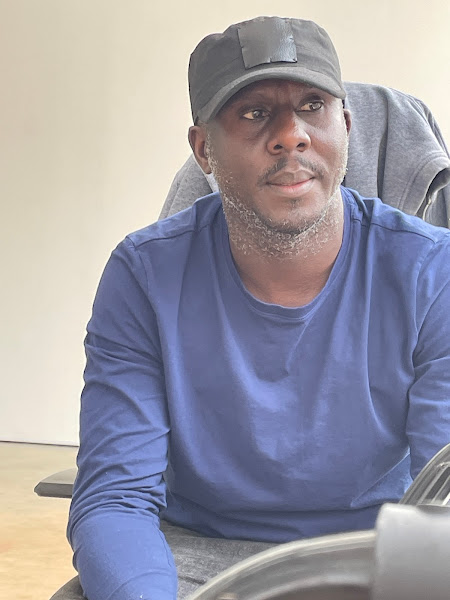Sunday, 18 June 2023
WASSWA’S ‘IMMORTAL OBJECTS’ ROUSE AWE AND WONDER
By Margaretta wa Gacheru (posted june 18, 2023)
Donald Wasswa may look like a scribbler, a doodler who delights in swirling thick brushes across giant canvases in shades of ochre and brown, black on white, or orange on orange.
But that would be a giant misunderstanding of this gifted Ugandan artist’s work, on display at Circle Art Gallery’s new venue off Riara Road. For one thing, his first solo exhibition in Kenya, entitled ‘Immortal Objects’ features both sculptures as well as paintings, both of which arrest your attention even before you enter the glass doors of the gallery.
The other critical distinction between the first impression of his paintings and the reality of the way this methodical artist works, has to do with the way he layers his colors, subtracting the portions that don’t reflect the shape he has in mind. But then he can add and subtract, add and subtract his colors until he attains the exact abstract image that he feels is the impression he desires.
“That’s why my paintings have [a thickness of] texture,” Wasswa tells BD Life a day after his opening, and the day before he’s departing, returning again to his home and studio in Entebbe. He had previously been based in Kampala, where he had studied fine art and design at Kyambogo University in Uganda’s capital city. “But I find Entebbe less chaotic and congested than Kampala,” the artist adds, noting he also has more space to think and develop his ideas, and keep all of his tools and materials.
Explaining how one particular painting evolved, one can feel how each of his works has a history of its own, since none of them are generated over night. One bright orange work down at the far end of the gallery is the one I tell him I would have in my living room as a warm welcome to visitors. It’s so luminous and cheery, I am surprised when he says the piece had originally contained lines of black which he ended up painting over several times. But finally, after adding and subtracting various shades of sunshine orange, he was satisfied with his ‘immortal object’ that he entitled ‘Zalwango’.
“I named it after my sister,” Wasswa says, noting that none of his painting or sculptures are meant to be ‘untitled’. It’s as if they all deserve a specific identity since he has gotten to know them well while they took shape and form.
“I actually majored in painting. It seemed that was what we were meant to do at school. But then I discovered I loved sculpture, so now my paintings are more influenced by my sculptures,” he adds.
He further explains that his paintings were not so heavily layered with both acrylics and oils until after he got into sculpture. “Now I feel I approach my paintings from the point of view of a sculpture,” rather than the other way around.
Indeed, as fascinating as his monumental paintings are, be they in black on white, black on blue with a hint of brown, or (my other favorite) various shades of brown, ochre, and beige backed by a gentle sky blue, it’s Wasswa’s sculptures that rank most significantly as ‘Immortal Objects’. The sculptures as well as his ink drawings of otherworldly beings can easily be understood as ‘immortal’.
The sculptures qualify for the perfection of their geometric configurations. Both in form and content, they are exquisite in the sense that his woods are indigenous, shaped to a lineal smoothness with a polish that brings out the natural grains in his Albizia wood as well as his curvaceous ebony.
He actually has three styles of well-polished sculptures in this show. There are the purely geometric forms, those that are either refined into angular lines of elegance and sharply-pointed grace or those made out of spherical balls which Wasswa says are derived from single pieces of wood.
Then there is the third style of his sculpture, the bulbus shaped beings, each with one copper-lined eye, and given a creeping (or is it creepy?) quality with their slender elongated Ebony tentacles that allow them to stand independently. These are the characters that could best qualify to be ‘immortal objects’ since they belong not to this world as replicas of any natural form that I know (although Nature has infinite possibilities and the oceans have yet to reveal all the identities still surviving at unfathomable depths).
Finally, inked entities are even more original in their identities apart from having originated in Wasswa’s marvelous imagination.
Subscribe to:
Post Comments (Atom)









No comments:
Post a Comment